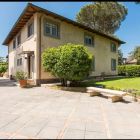A new look for the centro storico
If you have noticed some upheaval in the centre of Rome of late, it is probably not an isolated piece of maintenance work but rather part of a master-plan to pedestrianise many of the citys squares and streets and modernise the historic centre.
This ambitious revamping project has been directed by the active city council department for urban planning over the past few years but has entered its busiest phase this year. One of the sites where building work is currently most visible (and scheduled to finish by the beginning of 2005) concerns the area between Largo di Torre Argentina and Piazza della Rotonda, the so-called Capranica axis.
The project foresees not only the pedestrianisation of a large area of the historic centre from Largo di Torre Argentina to Piazza del Parlamento, but also the laying down of fibre-optic cables and the modernisation and reorganisation of the sewage works and other services below street level. To make the streets more pedestrian-friendly, some of them will have a pavement area on either side delineated by squat bollards connected by chains, like the ones that already adorn Piazza Montecitorio. The central section of these roads will be reserved for authorised vehicles only and re-laid with cobblestones (sampietrini), some set out in shell shapes, a tradition that dates back to the 19th century in Rome and disperses pressure on the road surface. Under the proposed plans, the road blocks to the pedestrian area (small columns which can be lowered into the ground) will be operated by remote control devices that will be given only to the areas residents, shopkeepers, office-workers and hotels.
We talked at length to all the neighbourhood associations and shopkeepers to try and strike the right balance, explains the commissioner for urban planning Roberto Morassut. He says his department had to resist the pressures of a fairly influential group of the areas residents made up of TV journalists and lawyers, who urged the council to keep things the way they are. Morassut insists the benefits of the project will be felt by all. Piazza Capranica is an open-air parking lot at the moment, he says. In fact the entire area is ravaged by illegal parking, including Piazza del Parlamento where the impressive and monumental staircase to parliaments back entrance and two Liberty-style lamps are eclipsed by the traffic. The project foresees the creation of a larger pedestrian area in front of the steps. Traffic through the square will be channelled into clearly delineated lanes and reduced to the bare minimum and in future politicians vehicles, which are now left all over the square, will be confined to the existing car park located between Via della Missione and Via di Campo Marzio.
Elsewhere in Rome, Morassuts department is equally busy. Piazza dellOrologio near the Chiesa Nuova will be entirely pedestrianised using the same bollard system as in the Capranica area. Work is also either underway or imminent in the Trinit dei Monti area, Piazza di Spagna and Piazza Mignanelli, and Piazza Navona. In all cases the council is using the opportunity to modernise and replace much of the citys wiring and sewage system.
Work in Piazza Navona has been delayed, Morassut admits, due to various sticking points between his department and the superintendencies for archaeology and monuments, including the fear that the
ancient remains under the square might be damaged. Another contentious issue is the removal of the large, raised central section in Piazza Navona to return it to its 17th-
century appearance. About 80 per cent of the square will be brought to only one level, explains Morassut, just like what was done in Campo de Fiori in 2000. Only the bars or restaurants will maintain a piece of pavement in front for their tables. The superintendence for archaeology has argued that the central section was built in the 19th century and so has a historical validity of its own. But Morassut says that whether consciously or not, pavements condition the free circulation of people, even in a square like Navona where the traffic is extremely restricted. He says the problems have just about been ironed out and we will soon be starting the tendering process for the contracts.
One very noticeable aspect of the modernisation project in Rome is the standardisation of newsstands, souvenir kiosks, rubbish bins and street benches. Many new, dark green, octagonal newspaper kiosks resembling tourist information points have been erected and new rules govern where they are located. In the Capranica area for example, the newsstands which have been moved several times in recent years will be definitively relocated in Piazza di S. Chiara and Piazza Capranica. For the first time in 50 years, Romes development plan defines both where newsstands should be located, and what they should look like, Morassut beams. Compared to the ramshackle tin structures of the past, the new booths are certainly larger, prettier and a lot more functional.
Under the nuovo piano regolatore or urban development plan approved in March 2003, neighbourhoods such as Monti, Trastevere, Testaccio and Ostiense are now also considered part of the citt storica, the historic city, and will enjoy the same safeguarding and promotion policies as the centre. Via Merulana, for example, which runs between the basilicas of S. Maria Maggiore and S. Giovanni in Laterano, is being entirely resurfaced, and pavements and public transport stops are being enlarged. It is also being fitted with a special walkway for visually-impaired people. Piazza di S. Egidio and Piazza S. Maria in Trastevere are also in line for restructuring, and in Viale della Piramide Cestia in Testaccio a new cycle path will be created alongside the tram tracks.
The repaving of Piazza della Maddalena is part of the city councils plan to make the Pantheon area more pedestrian-friendly.





















